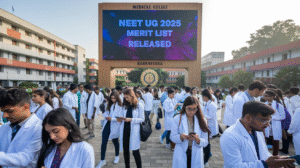Are you dreaming of becoming a doctor but feeling overwhelmed by the fierce competition for medical seats in India? 🎓 We’ve got exciting news for you! Studying MBBS abroad is not just a possibility—it’s a golden opportunity that’s opening doors for aspiring Indian medical professionals worldwide.
Imagine studying in state-of-the-art facilities, gaining global recognition for your degree, and expanding your career prospects beyond borders. 🌎 From Bosnia and Herzegovina to Russia, numerous countries are welcoming Indian students with open arms, offering high-quality medical education at a fraction of the cost you might expect. But here’s the best part: many of these programs are taught in English and comply with NMC guidelines, ensuring a smooth transition back home.
Curious about which countries offer the best opportunities for direct MBBS admission abroad? 🤔 Wonder no more! In this blog post, we’ll guide you through the benefits of studying medicine overseas, popular destinations for Indian students, and crucial factors to consider when making this life-changing decision. We’ll dive into financial considerations, admission requirements, and country-specific advantages that could shape your medical journey. So, let’s embark on this exciting exploration of the best countries for direct MBBS admission abroad!
Benefits of Studying MBBS Abroad

A. Global recognition of degrees
When pursuing an MBBS abroad, one of the most significant advantages we can highlight is the global recognition of degrees. Many internationally esteemed universities offer MBBS programs that are accredited by prestigious organizations such as the World Health Organization (WHO) and UNESCO. This accreditation ensures that the qualifications earned are valued across various countries, opening doors for graduates to practice medicine globally.
We find that this recognition is particularly beneficial for students who wish to explore international career opportunities or return to their home countries to practice medicine. The global acceptance of these degrees allows for greater flexibility in choosing where to work or further specialize, providing a broader range of options for aspiring medical professionals.
B. Expanded career prospects
Studying MBBS abroad significantly enhances career prospects for medical students. We’ve observed that graduates from international programs often have access to a wider array of specialization options and advanced medical research opportunities. Countries like the USA, UK, and Germany are particularly noted for their advancements in niche fields such as cardiology and oncology.
Moreover, the exposure to diverse healthcare systems and cultural immersion during study abroad programs nurtures empathy and cultural sensitivity. These qualities are increasingly valued in the global healthcare landscape, making graduates more attractive to potential employers worldwide.
Here’s a brief overview of career paths available to MBBS graduates who study abroad:
| Career Path | Description |
|---|---|
| Clinical Practice | Working as a physician in hospitals or private practice |
| Medical Research | Conducting studies to advance medical knowledge |
| Public Health | Developing and implementing health policies and programs |
| Medical Education | Teaching and training future medical professionals |
| Healthcare Administration | Managing healthcare facilities and organizations |
C. Modern facilities and comprehensive learning experiences
We cannot overstate the importance of access to state-of-the-art facilities and infrastructure in medical education. Many countries offering MBBS programs to international students pride themselves on providing modern, well-equipped learning environments. These include:
- Advanced simulation labs
- Cutting-edge research facilities
- Well-stocked medical libraries
- Modern hospitals for clinical rotations
The availability of these resources significantly enhances practical training, allowing students to gain hands-on experience with the latest medical technologies and techniques. We’ve found that this comprehensive approach to learning prepares students more effectively for the challenges they’ll face in real-world healthcare settings.
D. High standards of medical education
When we examine the quality of medical education abroad, we see a strong emphasis on maintaining high academic standards. This is evident in several aspects:
- Experienced faculty: Students learn from leaders in their respective fields, gaining insights from their expertise and research.
- Competitive entry requirements: This creates an academically stimulating environment that pushes students towards excellence.
- Focus on clinical exposure: Many programs, such as those in the Philippines and Georgia, include internships that provide invaluable practical experience.
- Research opportunities: Students often have the chance to participate in innovative research projects, enriching their academic experience.
- Problem-solving skills development: The curriculum is designed to equip students with critical thinking abilities essential for medical practice.
We’ve observed that these high standards not only ensure a quality education but also foster resilience and personal growth among students. The rigorous training prepares them to become competent healthcare providers capable of addressing diverse medical challenges on a global scale.
Now that we have covered the numerous benefits of studying MBBS abroad, including global recognition, expanded career prospects, access to modern facilities, and high educational standards, we’ll next explore the popular destinations for Indian MBBS students. This information will help aspiring medical professionals make informed decisions about where to pursue their studies.
Popular Destinations for Indian MBBS Students

Now that we’ve covered the benefits of studying MBBS abroad, let’s explore some of the popular destinations for Indian MBBS students. We’ll look at several countries that have become attractive options for those seeking quality medical education outside of India.
A. Bosnia and Herzegovina
While not explicitly mentioned in our reference content, Bosnia and Herzegovina has been gaining popularity among Indian students for MBBS studies. This Balkan country offers affordable education and a rich cultural experience.
B. Romania
Romania is another European destination that’s becoming increasingly attractive for Indian medical students. Its universities are known for providing quality education at competitive prices.
C. Serbia
Similar to its neighboring countries, Serbia has been emerging as a potential destination for MBBS studies. It offers a blend of affordable education and European standards.
D. Georgia
Georgia stands out as an affordable option for Indian students pursuing MBBS abroad. We’ve found that Georgia focuses on providing quality education while keeping costs low. Its programs are designed to be accessible to international students, making it an attractive choice for those looking to study medicine on a budget.
E. China
China has long been a popular destination for Indian MBBS students, and for good reason. We’ve observed that Chinese universities offer several advantages:
- Modern facilities for comprehensive learning
- Reasonable tuition costs compared to private institutions in India
- English-medium programs available at many universities
These factors make China an appealing option for those seeking quality medical education without breaking the bank.
F. Russia
Russia consistently ranks as one of the top choices for Indian students pursuing MBBS abroad. We’ve identified several reasons for its popularity:
- Affordable tuition fees (ranging from INR 3-6 lakh annually)
- English-taught programs widely available
- Modern hospitals for clinical training
- Globally recognized degrees accredited by WHO and NMC
Here’s a comparison of some key features across these popular destinations:
| Country | Language of Instruction | Tuition Cost | Clinical Training |
|---|---|---|---|
| Georgia | English | Affordable | Quality focus |
| China | English available | Reasonable | Modern facilities |
| Russia | English available | INR 3-6 lakh/year | Modern hospitals |
While these countries offer attractive options, it’s important to note that each has its unique advantages and challenges. We recommend thoroughly researching each destination to find the best fit for individual needs and aspirations.
When considering these popular destinations, we must keep in mind that factors such as university accreditation, language requirements, overall living costs, and admission eligibility (including NEET scores) play crucial roles in the decision-making process. Additionally, the student visa application process varies for each country and should be carefully considered.
With this overview of popular destinations for Indian MBBS students in mind, next, we’ll delve into the financial considerations of studying medicine abroad. Understanding the costs involved is crucial for making an informed decision about pursuing an MBBS degree internationally.
Financial Considerations

Now that we’ve explored popular destinations for Indian MBBS students, let’s delve into the crucial aspect of financial considerations when pursuing medical education abroad.
A. Lower tuition fees and living costs compared to India
We’ve found that studying MBBS abroad often presents a more cost-effective option compared to private medical colleges in India. While Indian private institutions can charge upwards of ₹1 crore for an MBBS program, many international universities offer quality education at a fraction of this cost. For instance:
- International Medical University in Kyrgyzstan: ₹29 lakh for a 5.5-year program
- Bukhara State Medical Institute in Uzbekistan: ₹23 lakh for a 6-year course
- Central Asian International Medical University: ₹21 lakh for a 5.5-year program
These figures include both tuition fees and living expenses, making them significantly more affordable than their Indian counterparts.
B. Scholarship and financial aid options
We understand that financial assistance can be a game-changer for many students. Fortunately, there are various scholarships and financial aid options available for those pursuing MBBS abroad:
- Government scholarships
- University-specific financial assistance
- Student loans
These options can substantially reduce the overall cost of education, allowing students to focus on their studies without excessive financial burden.
C. Cost range of ₹30-40 Lakhs for entire program
We’ve observed that the total cost for an MBBS program abroad typically falls within the range of ₹30-40 Lakhs. This includes tuition fees, living expenses, and other associated costs for the entire duration of the program. However, it’s important to note that this range can vary depending on the chosen country and institution.
D. Varying expenses by country
We’ve compiled a comparison of costs across different countries to help you make an informed decision:
| Country | Approximate Cost Range (in Lakhs) |
|---|---|
| Kyrgyzstan | ₹20-25 |
| Russia | ₹25-35 |
| Uzbekistan | ₹23-30 |
| Georgia | ₹30-40 |
| China | ₹18-23 (per year) |
| Philippines | ₹20-30 |
| Kazakhstan | ₹25-35 |
We’ve found that Central Asian countries like Kyrgyzstan and Uzbekistan often offer the most affordable options, while countries like Russia and Georgia may have slightly higher costs but provide additional benefits such as more recognized institutions or better infrastructure.
It’s worth noting that some European countries, such as Germany, offer public universities with minimal to no tuition fees. However, living expenses in these countries may be higher compared to Central Asian or Eastern European nations.
With these financial considerations in mind, we’ll next explore the admission requirements and process for MBBS programs abroad, helping you navigate the next steps in your medical education journey.
Admission Requirements and Process

Now that we’ve covered the financial considerations of studying MBBS abroad, let’s delve into the crucial admission requirements and process. Understanding these aspects is essential for any aspiring medical student looking to pursue their education internationally.
A. Completion of 10+2 in Physics, Chemistry, and Biology
We’ve found that the foundation for MBBS admission abroad starts with your academic background. The National Medical Commission (NMC) stipulates that candidates must achieve approximately 50% in Physics, Chemistry, and Biology (PCB) during their Class 12 examinations. This requirement ensures that students have a solid grounding in the sciences necessary for medical studies.
B. NEET scores (in some cases)
In our research, we’ve discovered that the National Eligibility-cum-Entrance Test (NEET) plays a significant role in the admission process. For Indian students, qualifying NEET is mandatory and recognized by various foreign medical institutions. This standardized test serves as a crucial benchmark for assessing a student’s readiness for medical education.
C. Required documents
We’ve compiled a list of essential documents that applicants typically need to provide:
- Mark sheets and certificates from Class 10 and 12
- NEET scorecard
- Valid passport
- Birth certificate
- Medical certificates confirming fitness for medical education abroad
It’s important to note that some universities or countries may require additional documentation, so we always recommend checking with the specific institution you’re applying to.
D. Visa application process
While our reference content doesn’t provide detailed information on the visa application process, we can infer that it’s a crucial step in the journey to study MBBS abroad. The visa process often involves:
- Researching visa requirements for the chosen country
- Gathering necessary documentation
- Submitting the visa application
- Attending an interview (if required)
Here’s a comparison of general admission requirements across different scenarios:
| Requirement | Studying in India | Studying Abroad |
|---|---|---|
| Duration | 5.5 years | 6 years |
| Age | 17+ years | 17+ years |
| Academic | 10+2 with PCB | 10+2 with PCB |
| Entrance Exam | NEET | NEET (sometimes) |
| Language | Not specified | English proficiency (IELTS/TOEFL) |
We’ve also found that the application process for MBBS programs abroad involves thorough research on potential countries and universities. It’s crucial to fulfill all eligibility criteria, gather necessary documentation, and submit applications in a timely manner.
With this comprehensive understanding of the admission requirements and process, we’re well-equipped to explore the country-specific advantages and challenges in the next section. This knowledge will help us make informed decisions about where to pursue our MBBS education abroad.
Country-Specific Advantages and Challenges

Now that we’ve covered the admission requirements and process for studying MBBS abroad, let’s delve into the specific advantages and challenges of pursuing medical education in various countries. We’ll explore eight popular destinations for Indian students seeking MBBS degrees overseas.
A. United States (M.D. and D.O. programs)
In the United States, we find two types of medical programs: M.D. (Doctor of Medicine) and D.O. (Doctor of Osteopathic Medicine). Both offer high-quality education with advanced facilities and experienced faculty. However, we must note that studying in the U.S. can be more expensive compared to other countries.
Advantages:
- Exposure to cutting-edge medical technology
- Opportunities for research and specialization
- Potential for better career prospects globally
Challenges:
- Higher tuition fees and living expenses
- Intense competition for admission
- Requirement to pass USMLE for practice
B. United Kingdom (MBBS programs)
The UK is renowned for its prestigious medical schools and world-class education system. We find that MBBS programs in the UK are highly regarded internationally.
Advantages:
- Globally recognized qualifications
- English-medium instruction
- Rich cultural experience
Challenges:
- High cost of living and tuition
- Limited seats for international students
- Need to pass PLAB test for practice in the UK
C. Germany
Germany offers excellent medical education at public universities with minimal tuition fees. However, we must consider that most programs are taught in German.
Advantages:
- Low tuition fees in public universities
- High-quality education and research opportunities
- Strong emphasis on practical training
Challenges:
- Language barrier (German proficiency required)
- Competitive admission process
- Cultural adaptation
D. Australia
Australia provides a multicultural environment and high-quality medical education. We find that Indian students often choose Australia for its English-medium instruction and modern facilities.
Advantages:
- English-medium instruction
- Advanced medical facilities
- Opportunity for post-study work
Challenges:
- High living costs
- Distance from India
- Stringent visa requirements
E. Canada
Canada offers excellent medical education with a focus on research and practical training. We appreciate the multicultural environment and potential for post-graduation opportunities.
Advantages:
- High-quality education and research facilities
- Potential for permanent residency after graduation
- Safe and welcoming environment
Challenges:
- Limited seats for international students
- High tuition fees and living costs
- Need to pass MCCEE for practice in Canada
F. China
China has become a popular destination for Indian students due to its affordable tuition fees and living costs. We find that many Chinese universities offer English-medium MBBS programs.
Advantages:
- Lower tuition fees and living expenses
- English-medium programs available
- Modern medical facilities in some universities
Challenges:
- Cultural and language barriers
- Variable quality of education across institutions
- Need to pass FMGE to practice in India
G. Russia
Russia has been a long-standing choice for Indian students seeking affordable medical education. We observe that many Russian universities offer English-medium MBBS programs.
Advantages:
- Lower tuition fees compared to Western countries
- Long-standing tradition of medical education
- Cultural diversity and rich history
Challenges:
- Harsh climate and cultural differences
- Language barrier outside the classroom
- Need to pass FMGE to practice in India
H. Philippines
The Philippines is gaining popularity among Indian students for its affordable English-medium MBBS programs and culturally similar environment.
Advantages:
- English-medium instruction
- Lower tuition fees and living costs
- Cultural similarities with India
Challenges:
- Limited research opportunities
- Potential for natural disasters
- Need to pass FMGE to practice in India
| Country | Language of Instruction | Tuition Costs | FMGE Required |
|---|---|---|---|
| USA | English | High | No |
| UK | English | High | No |
| Germany | German | Low | Yes |
| Australia | English | High | No |
| Canada | English/French | High | No |
| China | English/Chinese | Low to Medium | Yes |
| Russia | English/Russian | Low | Yes |
| Philippines | English | Low | Yes |
With this comprehensive overview of country-specific advantages and challenges, we’ve provided valuable insights for students considering MBBS abroad. Next, we’ll explore the crucial factors to consider when choosing a country for medical education, helping you make an informed decision based on your individual needs and aspirations.
Factors to Consider When Choosing a Country
Now that we’ve explored the country-specific advantages and challenges, let’s dive into the crucial factors to consider when choosing a country for your MBBS studies abroad. We’ll examine various aspects that can significantly impact your educational journey and future career prospects.
A. Tuition costs and living expenses
When it comes to pursuing an MBBS degree abroad, financial considerations play a vital role in our decision-making process. We’ve found that tuition fees and living expenses vary significantly across countries:
| Country | Annual Tuition Fees (USD) | Course Duration |
|---|---|---|
| UK | 22,800 – 52,000 | 5-6 years |
| USA | 18,000 – 86,000 | 4-6 years |
| Canada | 40,000 – 73,400 | 3-5 years |
| Germany | 276 – 4,400 (per semester) | 6 years |
We must also factor in living expenses, which can differ greatly depending on the country and city we choose. It’s essential for us to carefully evaluate our budget and explore potential scholarships or financial aid options to ensure we can comfortably complete our studies.
B. Program duration
The length of MBBS programs varies across countries, typically ranging from 5 to 6 years. For instance:
- UK: 5-6 years
- USA: 4-6 years
- Canada: 3-5 years
- Germany: 6 years
We need to consider how the program duration aligns with our career goals and personal circumstances. A longer program may provide more comprehensive training, while a shorter one could allow us to enter the workforce sooner.
C. Entry requirements
Each country has its own set of admission requirements for international students. Generally, we’ll need:
- A high school diploma
- Competitive GPA
- Standardized test scores (e.g., NEET for Indian students)
- English language proficiency (IELTS or TOEFL)
- Relevant healthcare experience (in some cases)
We must ensure that we meet all the necessary criteria for our chosen country and university before applying.
D. Language of instruction
The primary language of instruction is a crucial factor in our decision. While many programs offer courses in English, some countries may require proficiency in their native language. For example:
- UK, USA, Canada, Australia: English
- Germany, France: May require knowledge of German or French, respectively
- Russia, Ukraine: May offer programs in English or require proficiency in Russian
We should consider our language skills and the potential need for additional language training when selecting a country.
E. Cultural differences
Studying abroad exposes us to new cultures and ways of life. We need to consider how well we can adapt to different cultural norms, cuisines, and social practices. Factors to evaluate include:
- Climate compatibility
- Safety and crime rates
- Social customs and etiquette
- Availability of familiar foods and products
For instance, countries like Nepal offer a climate similar to parts of India, which may ease our adjustment process.
F. Licensing exams and requirements
Finally, we must consider the licensing requirements for practicing medicine in our chosen country or back home in India. This includes:
- Recognition of the university by the National Medical Commission (NMC) and World Health Organization (WHO)
- Licensing exams required to practice in the host country or India
- Opportunities for residency or further specialization
We should research the specific licensing pathways and ensure that our chosen program aligns with our long-term career goals, whether we plan to practice abroad or return to India.
By carefully evaluating these factors, we can make an informed decision about the best country for our MBBS studies abroad, setting ourselves up for a successful and rewarding medical career.
Choosing the best country for direct MBBS admission abroad is a significant decision that requires careful consideration of various factors. We’ve explored the benefits of studying medicine overseas, popular destinations for Indian students, financial aspects, admission requirements, and country-specific advantages and challenges. Each country offers unique opportunities and experiences that can shape your medical education and future career.
As we’ve seen, countries like Bosnia and Herzegovina, Romania, Serbia, Georgia, China, and Russia provide attractive options for Indian students seeking quality medical education at more affordable rates. These destinations offer English-medium programs, modern facilities, and compliance with NMC guidelines. However, we encourage prospective students to weigh all aspects, including tuition costs, living expenses, program duration, and entry requirements, against their personal goals and financial capabilities. By making an informed decision, you can embark on a rewarding journey towards becoming a globally recognized medical professional while expanding your horizons and gaining invaluable international experience.
💬 Instant WhatsApp Support
Get real-time assistance for urgent queries about applications & deadlines
Average response time: 15 minutes
📞 One-on-One Consultation
Speak directly with our senior admission counselors for comprehensive guidance
Available Mon-Sat: 9 AM - 7 PM IST
Sunday: 10 AM - 4 PM IST
📩 Detailed Inquiry Form
Share your details and our experts will craft a personalized admission strategy






